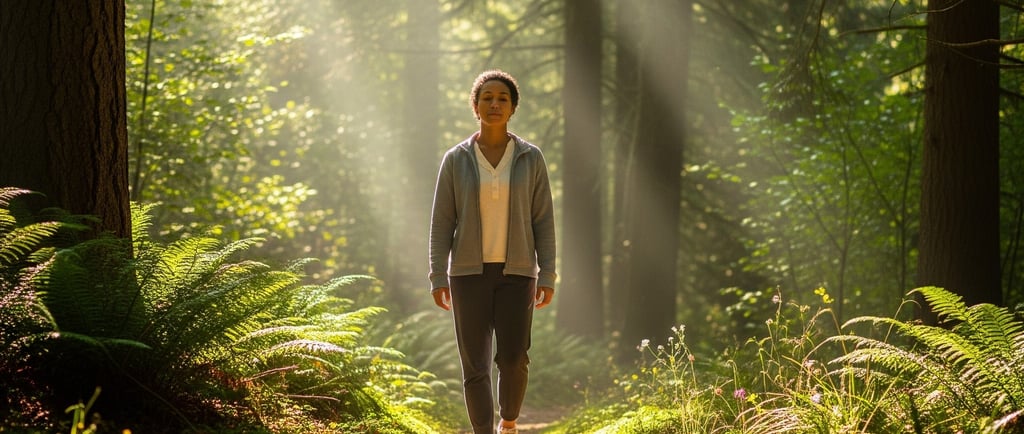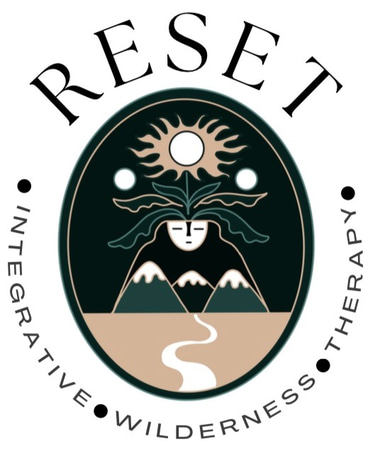Nature's Prescription
The Surprising Physical Benefits of Spending Time Outdoors
Dr. Danny Alva
7/22/20257 min read


In our fast-paced, screen-dominated world, the idea of "getting outside" often feels like a luxury, a pleasant diversion from the real demands of life. We chase deadlines, stare at screens, and navigate concrete jungles, often forgetting that our bodies and minds evolved in a very different landscape. Yet, a growing body of scientific evidence is revealing what ancient cultures and indigenous peoples have known for millennia: nature is not just a backdrop for our lives; it is a fundamental ingredient for our physical health and well-being. It is, in essence, a powerful prescription – a "Nature's Rx."
At Reset Integrative Wilderness Therapy, our mission is to strengthen our relationship with ourselves by discovering our relationship with nature. We believe that true health encompasses physical, mental, and emotional vitality, and that the wilderness offers a profound arena for achieving this holistic balance. As a Doctor of Physical Therapy, I’ve witnessed firsthand how reconnecting with the natural world can unlock incredible physical benefits, often surpassing what can be achieved within the confines of a gym or clinic. From boosting our immune systems to reducing chronic pain and enhancing our cardiovascular health, the outdoors offers a vast, free, and endlessly adaptable healing environment. This article will delve into the surprising physical advantages of embracing the great outdoors, inviting you to consider nature as an essential part of your health regimen.
The Immune System’s Natural Ally: Forest Bathing and Phytoncides
One of the most compelling physical benefits of spending time in nature lies in its profound impact on our immune system. The concept of "forest bathing," or Shinrin-yoku as it’s known in Japan, has gained significant attention worldwide for its remarkable health-promoting effects. It's not about swimming in a forest or bathing in a literal sense; it’s about immersing oneself in the atmosphere of the forest through all five senses.
When we breathe in the air of a forest, we inhale a cocktail of airborne chemicals called phytoncides. These organic compounds are emitted by trees and plants as a defense mechanism against insects and fungi. Remarkably, when humans inhale phytoncides, they trigger a beneficial biological response within our bodies. Studies have shown that exposure to phytoncides can significantly increase the activity and number of natural killer (NK) cells in our immune system (Heo, Park, & Jee, 2023). NK cells are a type of white blood cell that play a crucial role in fighting off viruses and even tumor cells. An increase in NK cell activity translates directly to a more robust immune defense, making us more resilient to illnesses and potentially even certain cancers (Heo, Park, & Jee, 2023).
Furthermore, the effects of a single forest bathing trip on NK cell activity can last for several days, and even up to a week after the exposure (Heo, Park, & Jee, 2023). This suggests that regular, even infrequent, immersion in nature can provide sustained immunological benefits. This isn't just a fleeting feeling of relaxation; it's a measurable, physiological change that strengthens our body's fundamental defense mechanisms. For those struggling with physiological deficits, as we classify in our Cognitive Systems Framework, improving baseline immune function is a critical step towards overall wellness and resilience.
Cardiovascular Health: The Heart-Pumping Power of Green Spaces
The benefits of nature extend directly to our cardiovascular system, impacting heart rate, blood pressure, and overall heart health. Engaging in physical activity outdoors naturally leads to improvements in cardiovascular fitness, but even passive exposure to nature seems to have a calming effect on our hearts.
Research indicates that spending time in green environments can lower heart rate and decrease blood pressure (Bauer & White, 2023). This effect is attributed to a reduction in stress hormones like cortisol and adrenaline, which, when chronically elevated, contribute to cardiovascular strain. The serene sights and sounds of nature—the rustling of leaves, the chirping of birds, the gentle flow of water—can activate the parasympathetic nervous system, often referred to as the "rest and digest" system (Bauer & White, 2023). This activation counteracts the "fight or flight" response of the sympathetic nervous system, promoting a state of physiological calm and recovery.
Beyond passive exposure, engaging in physical activities outdoors, such as hiking, walking, or trail running, provides a dynamic workout for your heart and lungs. Uneven terrain, varying inclines, and natural obstacles challenge your cardiovascular system in ways that treadmills and paved paths often cannot. This varied intensity, often referred to as "fartlek" training in sports science, improves endurance, strengthens the heart muscle, and enhances metabolic efficiency (Kumar, 2015). The fresh air, often less polluted than indoor or urban environments, also contributes to more efficient oxygen intake and utilization by the body. For individuals focusing on overcoming physiological deficits or managing cardiovascular conditions, integrating outdoor activity into their routine can be a highly effective and enjoyable intervention.
Pain Management: Nature’s Analgesic Effect
Persistent pain is a complex challenge, often influenced by both physical and psychological factors. While traditional physical therapy offers invaluable tools for pain management, nature provides a powerful complementary analgesic effect.
One primary way nature helps with pain is through stress reduction. Chronic stress can exacerbate pain perception and even contribute to the development of chronic pain conditions (Lee, et al. 2023). By lowering stress hormones and activating the parasympathetic nervous system, nature creates a physiological environment that is less conducive to pain signals (Lee, et al. 2023). The distraction offered by natural environments also plays a role; shifting focus from internal pain sensations to external stimuli like beautiful landscapes or interesting wildlife can reduce the brain's perception of pain.
Furthermore, natural environments often encourage gentle, varied movement. Walking on uneven trails, climbing over small obstacles, or simply stretching amidst trees provides proprioceptive input—information about our body's position in space—which can be crucial for pain modulation and improving body awareness. For those with persistent pain, engaging in "graded exposure" to physical activity in a supportive, natural setting can help rebuild confidence in movement and reduce kinesiophobia (fear of movement) (Ambegaonkar, et al., 2024). This aligns with our approach to addressing hyper-phobic tendencies.
Sleep Quality: Syncing with Nature’s Rhythms
In an era plagued by sleep disturbances, reconnecting with nature offers a surprisingly potent remedy. Our modern indoor lives, dominated by artificial lighting and constant digital stimulation, often disrupt our natural circadian rhythms – the 24-hour internal clock that regulates sleep-wake cycles (Jimenez, et al. 2021).
Spending time outdoors, especially during daylight hours, exposes us to natural light, particularly blue light, which is crucial for suppressing melatonin production during the day and signaling to our bodies that it's time to be awake and alert. Conversely, as daylight fades, exposure to natural darkness at night allows for the natural increase of melatonin, preparing our bodies for sleep. This natural light-dark cycle is essential for maintaining a healthy circadian rhythm and optimizing sleep quality (Jimenez, et al. 2021).
Physical activity outdoors also contributes significantly to better sleep. Exercise, particularly moderate to vigorous activity, has been shown to improve sleep duration and quality, reduce the time it takes to fall asleep, and decrease instances of insomnia (Jimenez, et al. 2021). When this exercise occurs in nature, the added benefits of fresh air and reduced stress amplify these effects. Even camping overnight, exposed to natural light cycles without artificial light, can powerfully reset our internal clocks, leading to more restorative sleep patterns. For individuals addressing physiological deficits or struggling with addictive tendencies that disrupt sleep, prioritizing outdoor time can be a foundational step toward regulating their body’s natural rhythms and improving overall health.
Enhanced Physical Activity and Fitness Levels
Perhaps the most direct physical benefit of spending time outdoors is the encouragement of physical activity. Natural environments often invite movement in ways that indoor spaces cannot. The desire to explore a winding trail, climb a gentle incline, or paddle across a lake naturally motivates us to move our bodies more.
Compared to exercising indoors, people tend to exert themselves more and feel less fatigued when exercising in natural environments, from what I’ve noticed. The "natural playground" encourages diverse movement patterns, helping to develop functional strength that translates directly to everyday activities and supports our focus on primal movements like squatting, lunging, and lifting.
Furthermore, the "green exercise" phenomenon suggests that physical activity performed in nature offers additional psychological benefits, such as increased enjoyment and reduced perception of effort, making us more likely to stick with our exercise routines long-term (Jimenez, et al. 2021). This sustained engagement with physical activity directly translates to improved cardiovascular health, stronger muscles and bones, better weight management, and reduced risk of chronic diseases (Jimenez, et al. 2021). For clients struggling with motivation or consistency, integrating outdoor elements into their personal training can provide the intrinsic drive needed to sustain their personalized movement journey.
Integrating Nature into Your Daily Rx: A Reset Approach
At Reset Integrative Wilderness Therapy, we believe in the transformative power of nature, not just as a location for our sessions, but as a living, breathing component of your personal growth. My background as a Doctor of Physical Therapy allows me to uniquely blend the clinical understanding of your body's needs with the profound healing capabilities of the natural world.
Our Holistic Growth Consultations and Personalized Movement Journeys are designed to help you harness these benefits. Whether it’s through guided outdoor experiences, nature-inspired exercises you can do anywhere, or simply incorporating mindful moments in a park near you, we guide you to integrate nature’s incredible power into your daily “Rx.” We focus on understanding your unique struggles and design interventions that connect you more deeply with yourself and the environment.
The physical benefits of spending time outdoors are undeniable and often synergistic with other wellness practices. By consciously inviting nature into your life, you are not just escaping the daily grind; you are actively investing in a deeper, more resilient, and healthier version of yourself. It's time to make "Nature's Rx" a fundamental part of your health and well-being.
-Dr. Danny Alvarez
Ready to start your journey with Nature's Rx?
Explore our services and schedule your Complimentary Well-being Exploration Call to discover how Reset Integrative Wilderness Therapy can help you achieve your holistic health goals.
Disclaimer: This blog post was written with the help of AI.
References
Heo, S. J., Park, S. K., & Jee, Y. S. (2023). Effects of phytoncide on immune cells and psychological stress of gynecological cancer survivors: randomized controlled trials. Journal of exercise rehabilitation, 19(3), 170–180. https://doi.org/10.12965/jer.2346150.075
Bauer, A., & White, N. D. (2023). Time in Nature: A Prescription for the Prevention or Management of Hypertension. American journal of lifestyle medicine, 17(4), 476–478. https://doi.org/10.1177/15598276231165662
Kumar, P. (2015). Effect of fartlek training for developing endurance ability among athletes. International Journal of Physical Education, Sports and Health, 2(2), 291-293
Lee, M. J., Pradeep, A., Lobner, K., & Badaki-Makun, O. (2023). The effect of nature exposure on pain experience and quality of life in patients with chronic pain: A systematic review and meta-analysis protocol. PloS one, 18(9), e0291053. https://doi.org/10.1371/journal.pone.0291053
Ambegaonkar, J. P., Jordan, M., Wiese, K. R., & Caswell, S. V. (2024). Kinesiophobia in Injured Athletes: A Systematic Review. Journal of functional morphology and kinesiology, 9(2), 78. https://doi.org/10.3390/jfmk9020078
Jimenez, M. P., DeVille, N. V., Elliott, E. G., Schiff, J. E., Wilt, G. E., Hart, J. E., & James, P. (2021). Associations between Nature Exposure and Health: A Review of the Evidence. International journal of environmental research and public health, 18(9), 4790. https://doi.org/10.3390/ijerph18094790
